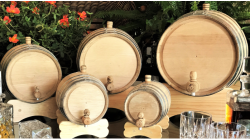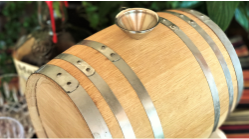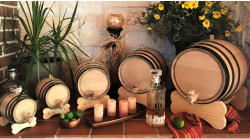View cart



Instructions & Barrel PrepYour New Barrel Keep your barrel shrink-wrapped, out of direct sunlight in a cool (55 - 60 degree) and optimally humid (65%-75%) area until ready to use. Barrel Prep Begin by rinsing out the barrel to remove any charred bits and pieces of wood that might have shaken loose in shipping. Using a rubber mallet, carefully tap in the spigot (just until snug) and refill the barrel with tap water. Fill the barrel with Water. It is normal for the barrel to drip until the wood has swelled. Once the dripping stops, keep the water in the barrel for an additional 24 hours to fully hydrate the staves. Empty and rinse again. Fill to the top with your favorite spirit. Using a twist, push and turn action place the bung/cork in tightly. Aging The length of time your spirits age and mellow in the barrel depends on personal taste. Small barrels will begin imparting oak flavor quickly - check every two to three weeks for taste and top off what has been lost to the angels' share. When pleased with your results, pour into your favorite decanter or bottle and enjoy. The Rule of Thumb for Aging in Smaller Barrels Using a smaller sized barrel changes the amount of surface area or the amount of wood barrel in contents.T This larger ratio of wood to liquor has a direct impact on the flavor and length of the aging process and is the very reason that aging in a smaller barrel is much faster. For example, liquor can be aged out in four to six months when aging in a 20 L barrel versus years using the standard large 53-59 gallon barrel. The rule of thumb for aging in smaller barrels: 20 L Oak Barrel - four to six months 10 L Oak Barrel - two to four months 5 L Oak Barrel - four to six weeks 2 L Oak Barrel - two to four weeks 1 L Oak Barrel - one to two weeks Check your barrels and their contents every couple of weeks - top off when necessary. Temperature and Humidity Temperature also impacts the aging process due to the amount of oxidation that occurs at different temperatures. Higher temperatures accelerate this process while lower temperatures result in slower oxidation. Ideally there would be great variations between night and day temperatures. These fluctuations in temperature, along with changes in barometric pressure, have been shown to actually force the whiskey, wine or ale in and out of the wood, resulting in maximum flavor and character. Oxygen enters a barrel when water or alcohol is lost due to evaporation - often called the "angels share". In an environment with 100% relative humidity, very little water evaporates and so most of the loss is alcohol - a useful trick of one has a liquor or wine with very high proof. Most beverages are topped up from other barrels or bottles to prevent significant oxidation. With small barrels, it's recommended to top off the barrel every one or two weeks. In a nutshell ... - Low Humidity - primarily water lost resulting in higher alcohol content. Dry air and higher temperatures will result in more water being lost (alcohol content goes up). - High Humidity - primarily alcohol lost resulting in losing the alcoholic strength of the product. When stored at 60% relative humidity or higher, primarily alcohol loss. Humid atmospheres with moderate temperatures will lead to more alcohol than water evaporating. Additional Information - As the barrels are a wood product, they are subject to the wood drying and shrinking. Oak Barrels, Ltd. offers no guarantee against shrinkage. - In order for the spigot to flow freely, please remember to remove the bung/cork before you open the spigot ... pour from the spigot ... then close the spigot and finally ... replace the bung/cork. - To keep your barrels performing and looking their best, please keep them stored in a protected area away from the elements and optimally in a cool and relatively humid area. - Barrels with painted black steel hoops are particularly susceptible to moisture. A little care goes a long way. Prevent excessive staining and rust by keeping the exterior of the barrel dry. - Avoid water stains by using a funnel to carefully fill your new barrel. - Sandpaper will generally remove any stains or marks on the barrel. - As the barrels are handcrafted, liquid volume is approximate. - You should be able to reuse your barrel from 3-5 times ... remember that each aging will take longer than the previous one. - Please do not nail or put screws into the hoops or staves as doing so will compromise the oak and might cause damage that is not covered by our return policy. - If you want to age a different type of spirit then was initially aged in it, we recommend you use a new barrel. - For your safety, if using chemicals to clean/sanitize your barrels, please follow the manufacturer's instructions for proper use. Enjoy your barrel - and have fun! |